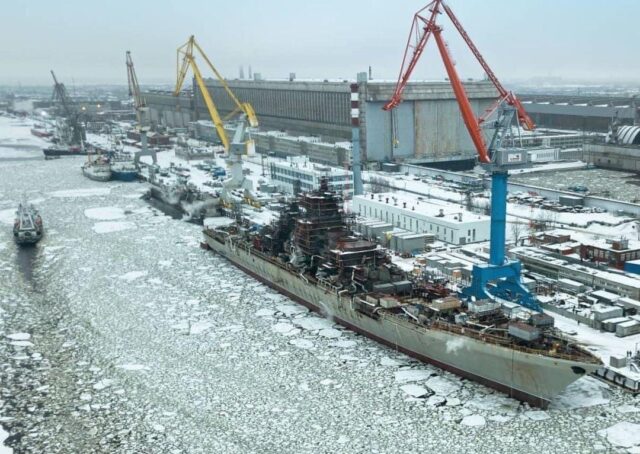
Russia’s Questionable Naval Modernization During Wartime
Publication: Eurasia Daily Monitor Volume: 20 Issue: 37
By:

The Russian Navy’s participation in the war against Ukraine has been mostly limited to the Black Sea Fleet and Caspian Flotilla. Yet, even with these limitations, Russia has still lost one of its five cruisers and several ships of other types during the conflict (see EDM, November 8, 2022). Together with reconsidering the roles and tasks of the Baltic and Northern fleets once Finland and Sweden finally join the North Atlantic Treaty Organization, one would think these developments would force Moscow to exhaustively reconsider its approach toward its navy; however, there is still no evidence that such a reconsideration is taking place. Additionally, little evidence supports the notion that the Russian shipyards have indeed extended working hours to boost the production of battleships for the Russian Navy during the war, which the Kremlin has characterized as a wider struggle against the West for Russia’s survival (see EDM, November 28, 2022; TASS, February 26).
Thus, Moscow continues its long-term naval approach, focusing on two primary goals: (a) maintaining and developing nuclear-powered submarine forces to preserve strategic parity with the United States and (b) developing conventional naval forces (including nuclear-powered vessels), which are meant to enable the Kremlin to project power during overseas operations in maintaining Russia’s role as a global actor. And instead of concentrating limited resources on a set number of projects, Moscow continues to spread itself too thin among the numerous fleets, research and design programs and shipyards.
Russian entity United Shipbuilding Corporation ended 2022 with a net loss that amounts to tens of billions of rubles (hundreds of millions of dollars), despite 380 billion rubles in reported revenue ($5.55 billion). The company has been further plagued by delays in the supply of new and repaired ships: now, six ships and submarines, instead of the originally planned 11 (Aoosk.ru, January 16; RIA Novosti, February 27). For example, completion of the repair and modernization of the nuclear-powered cruiser the Admiral Nakhimov has been postponed until 2024, which was originally planned for 2022. In truth, this process had already been delayed a couple times before. The problem here is that the repair and modernization of the same class cruiser, the Petr Velikiy, cannot be started before the Admiral Nakhimov becomes operational again. Meanwhile, the completion date for the repair and modernization of Russia’s only aircraft carrier, the Admiral Kuznetsov, has also been postponed to 2024 (TASS, April 7, 2021; Interfax-AVN, August 15, 2022; RIA Novosti, February 27).
Indeed, in the naval dimension, as of yet, the only clear vision the Russian military leadership has developed is that it needs more cruise missiles on each of the new and modernized ships as well as diesel-electric submarines (see EDM, February 24). Almost all other considerations are still a matter of discussion. For instance, the future of the long-term Project 677 for the development of advanced diesel-electric submarines is still not clear largely due to the absence of well-developed technologies for Russia’s air-independent power systems (Riddle Russia, July 28, 2021). Future development of nuclear-powered missile destroyers or new aircraft careers merely remains an idea on paper. Additionally, a decision has yet to be made whether the Admiral Gorshkov-class frigate project (project 22356) can be further expanded or if new and more powerful frigates should instead be developed.
Another point of discussion is whether Russia will bet on further modernization of the currently produced Borei- and Yasen-class nuclear-powered submarines, or if Moscow will invest in producing new and still non-existent generations of nuclear-powered submarines after 2030. Currently, it seems that the former option will be more likely as United Shipbuilding is completing efforts to decrease the construction timetable for these classes of submarines from eight to seven years. Thus, the development of new generations promises to be prolonged for decades (Interfax-AVN, August 15, 2022; RIA Novosti, February 27).
Perhaps the most important factor influencing Russian plans and discussions regarding its conventional vessels is related to naval engines. Since 2014, Russia has successfully reverse-engineered Ukrainian-made naval gas turbine engines and developed 20-megawatt M90FR gas turbines for its M55R CODAG naval engines. Even so, Russia’s production capacity here is limited to two engines per year, and each Gorshkov-class frigate needs two engines to function properly (FlotProm, June 23, 2021). Additionally, the same two engines are needed for the two large landing ships onboard, equipped with combat helicopters wings (project 23900). These ships are considered to be relative counterparts of the French-made Mistral-class ships and, since 2020, have been being built in occupied Crimea by Ak-Bars Corporation, which belongs to the main political clan of Tatarstan. Moreover, Moscow’s permanent interest in nuclear-powered battleships testifies that severe technological and industrial problems will not allow Russia to develop and produce more powerful naval gas turbine engines any time soon (RIA Novosti, February 27).
As a result, the lack of resources should force the Kremlin to change the organizational structure of its shipbuilding industry. Recent rumors about a possible merger between United Shipbuilding and Ak-Bars, as well as the possible direct engagement of Rosatom in the shipbuilding industry, underline the fact that the Russian leadership is looking for opportunities to lighten the financial and industrial burdens in its shipbuilding capacities without needing to wholly reconsider its naval strategy (Aoosk.ru, January 16; RIA Novosti, February 27).



